#monks of thelema
Explore tagged Tumblr posts
Text
Basis of the demon cult
I am very intrigued by all this, but there are major corrections to make.
First of all, the Sir Francis Dashwood who founded this secret society lived from 1708 to 1781, so he was dead long before the Victorian era. Basically, these high society men gathered together, hired a group of prostitutes, dined together, got drunk, and engaged in whatever activities they pleased. They also made various offerings to statues of pagan gods and goddesses. Some of the statues might have been moved to the abbey and, later, the caves... but many were located at his home estate.
The abbey they rented for their exploits was at Medmenham, but it didn't look like the church used in the manga. However, Wikipedia says he and his fellow renters of the abbey restored it in the style of 18th century Gothic Revival, so that could explain Yana-san's choice of styles in the manga.

Not far away, he had a church built on a hill, though I do not know what it looks like. The area has this St. Peter's parish church (below), but I do not know if it's the one he had built.

Later, meetings were held in the Hellfire Caves.

The society broke apart in the 1760's, probably by 1766.
During the late 19th century, people started to associate Dashwood's former Monks of Medmenham or Hellfire Club with black masses and demon worship. It is not known whether they engaged in worshipping demons, but they did do mock rituals for pagan deities, as mentioned above.
The "Do as thou wilt" phrase used by Dashwood, Aleister Crowley, and the Kuroverse demon-worshipping cult, all stem from the fictional Abbaye de Thélème, mentioned in Gargantua and Pantagruel by Rabelais in the 16th century. What you might call an anti-monastery. A place for hedonistic rituals.
After Dashwood's death, a nephew of his founded the Phoenix Society. From Wikipedia, on the Hellfire Club:
In 1781, Dashwood's nephew Joseph Alderson (an undergraduate at Brasenose College, Oxford) founded the Phoenix Society (later known as the Phoenix Common Room), but it was only in 1786 that the small gathering of friends asserted themselves as a recognised institution.[48] The Phoenix was established in honour of Sir Francis, who died in 1781, as a symbolic rising from the ashes of Dashwood's earlier institution.
Thelema also uses a Phoenix as one of its symbols. Please check out my posts about #thelema for more about that one, including their use of symbols, like the Phoenix.
There is also a novel, The Monks of Thelema, from 1878. Here's an online edition from 1884.
I'd say that the Viscount of Druitt (Aleister Chambers) is mostly based on Aleister Crowley, though he might also be associated with this demon cult and more vaguely based on Sir Francis Dashwood.
I'd say the demon cult is like a cross between Dashwood's "Hellfire" club and Crowley's Thelema. Time-wise, it's between the two, as well, but closer to Crowley's active era. Crowley himself is only a couple months older than our Phantomhive twins....
Probably a clue to the cult that kidnapped the twins
Ok, this is my first post here and I don't know much about English so I'll use the translator.I hope that a part of kurofandom can see this and tell me what they think.
hace unos días comencé a releer el manga del arco de revelación gemela, y como últimamente he estado investigando sobre arquitectura gótica/medieval, vi este panel del capítulo 135 y pensé "este castillo lo han tomado". parece que es medieval"
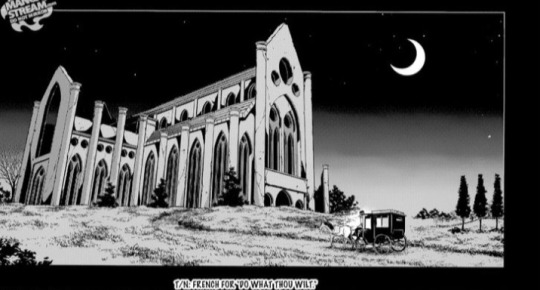
then the idea of looking for information on satanic sects during the Victorian era occurred to me, and although in reality there was very little information about it, after searching for a while I finally found a page that told me about what I was looking for.

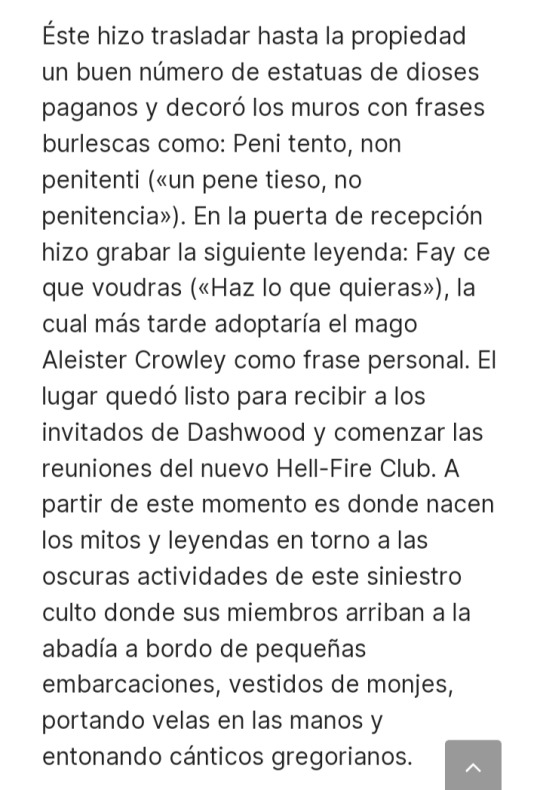
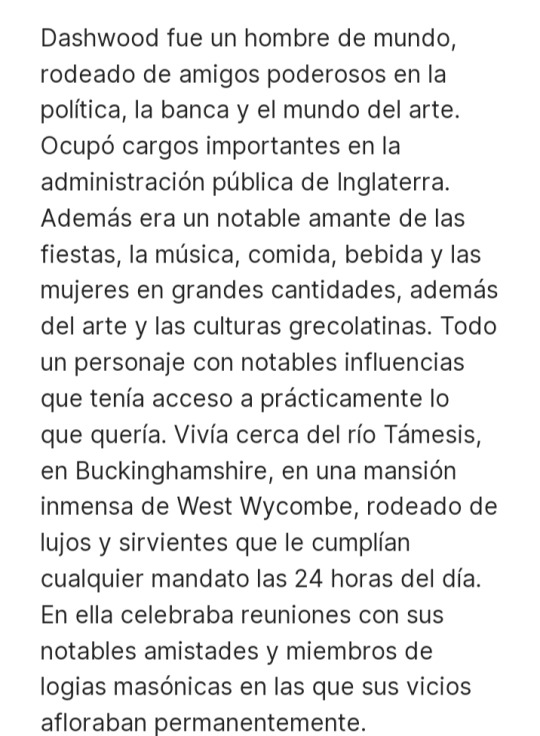


Well this information is about a man named Sir Francis Dashwood, like many of the young people of Victorian England who prided themselves on being part of blue blood families, he was an inexhaustible traveler. He toured almost all of Europe as part of his training, but he always expressed a very marked passion for Italy. Dashwood was a man of the world, surrounded by powerful friends in politics, banking and the art world. He held important positions in the civil service of England. He was also a notable lover of parties, music, food, drink and women in large quantities, in addition to art and Greco-Roman cultures. Quite a character with notable influences that he had access to practically what he wanted. He lived near the River Thames, in Buckinghamshire, in a huge mansion in West Wycombe, surrounded by luxuries and servants who fulfilled any mandate 24 hours a day. In it he held meetings with notable friends of his and members of Masonic lodges in which his vices surfaced permanently.
However, he had in mind the creation of a select secret group in which he could discuss freely about political and philosophical issues exclusively, made up of elegant and influential gentlemen from English high society. This is how he found the ideal place to carry out these meetings: Medmenham Abbey, whose owners were members of the Duffield family, and which was about five kilometers away from his mansion. The Duffields agreed to rent the property, erected around 1200 by a congregation of Cistercian monks. The place was perfect in every way: away from prying eyes and with an atmosphere of mysticism, thanks to its medieval air that enchanted Sir Francis.
He had a good number of statues of pagan gods moved to the property and decorated the walls with mocking phrases such as: Peni tento, non penitenti ("a stiff penis, no penance"). On the reception door he had the following legend engraved: Fay ce que voudras (<< Do what you want »), which would later be adopted by the magician Aleister Crowley as his personal phrase. The place was ready to receive Dashwood's guests and start the meetings of the new Hell-Fire Club. From this moment is where the myths and legends are born around the dark activities of this sinister cult where its members arrive at the abbey aboard small boats, dressed as monks, carrying candles in their hands and singing Gregorian chants.
It should be clarified that in reality the cult called themselves "The Monks of Medmenham". The name "Hell-Fire" club was more of a derogatory nickname.
So reading all this information I realized something, the phrase that this cult used was "fray ce que voudras" which means "Do what you want" or "Do your will" and this same phrase is used by the members of the cult that kidnapped to the twins.
In this part of chapter 135.
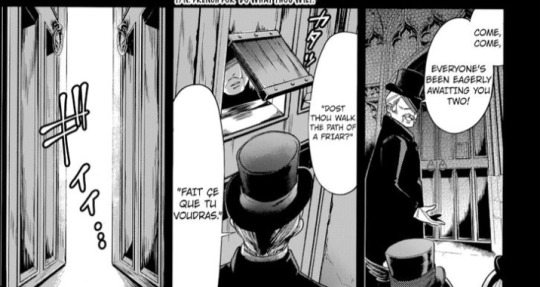
here I realized that when they arrive at that castle the receptionist asks "are you a monk?" To which the other responds with "Fay ce que voudras" (Do what you want). The same phrase used by members of the cult The Monks of Medmenham.
So I would assume that this is a hint that Yana left us and I don't see anyone else talking about it. I don't know if so many people from kurofandom follow me but tell me what you think about this, we should investigate further but I think this is a very obvious clue. 😸
#black butler#kuroshitsuji#demon cult#demon worship#sir francis dashwood#aleister crowley#aleister chamber#viscount of druitt#hellfire club#monks of medmenham#monks of thelema#thelema#rabelais#historical reference#black mass#do as thou wilt#observation#discussion#may 22 2023#phoenix society
253 notes
·
View notes
Note
Hey, I've gone through your blog and as a modern day Thelemite I'd like to thank you for the research you did into the history of the use of "do what thou wilt" in occultism, as the philosophy of Thelema doesn't in any way condone what happened to the twins. One of the reasons I admire your Kuro theories is because of the amount of research you do and it really shows. My knowledge of the phrase was only its' Thelemic context so I was worried when I read that scene that it would be misinterpreted
Do what thou wilt... within guidelines
Yeah, Crowley and his pals never would have condoned what happens to the twins in Kuroshitsuji, and I definitely made sure to point that out in one or more of my early posts about it. I'm glad you noticed that. 😊 Thelemic rituals often include sexual activities, but it requires that all participants be willing and adult.
According to Crowley, the best sacrifice -- theoretically -- for summoning would be a young and highly intelligent male virgin who offers himself up for the ritual. He also said that people who self-sacrifice (even if it's just blood-letting, not actually offing themselves) are more likely to get desired results. The cultists in the manga completely turn this on its head by choosing 1. unwilling 2. children 3. of random intelligence... 4. that they defile. 😡 They don't care about their chosen victims... and they definitely don't care about following the rules of Thelema. Crowley would despise people who abuse children. Anyone selected for sacrifice should never be made to even feel like a victim. Of course, most of this was theoretical; Crowley says he was too cowardly to use himself (spill his own blood) for summoning rituals, and that he never made a human sacrifice.
Anyway, as mentioned in one or two more recent posts, Crowley got the idea of Thelema -- and borrowed that phrase -- from a series of books by Rabelais, Gargantua and Pantagruel. I have yet to read them, but it sounds like there's a higher level of hedonism in there.... A pseudo-precursor to Thelema seems to also be based on the story, and they also used that phrase, but it was more like a dinner club... sort of -- the Monks of Medmenham. As I say in my addition to that post, they hired prostitutes and wined and dined with them before doing whatever else they wanted. They also made various (small, symbolic) offerings... but to statues of Pagan gods. Again, this wasn't about defiling and/or killing unwilling participants, particularly not children. In that post, I might not have made it clear, but I will here: though the cultists in the manga seem to be a cross between these two things -- Monks of Medmenham and Thelema -- they are clearly not following the rules of either one. The manga's cultists don't care about child welfare or consent or anything. The Monks of Medmenham and Thelemites, like yourself, would be appalled.
#black butler#kuroshitsuji#cultists#demon cult#thelema#aleister crowley#rabelais#gargantua and pantagruel#gargantua#pantagruel#monks of medmenham#historical figures#rocknrolloccultist93#i answered a thing#answered asks#analysis#jul 22 2023
24 notes
·
View notes
Text
Saints&reading: Saturday, August 26, 2023
august 13_august 26
Leavetaking of the Transfiguration of the Lord
TRANSLATION OF THE RELICS OF St MAXIMUS THE CONFESSOR (662)
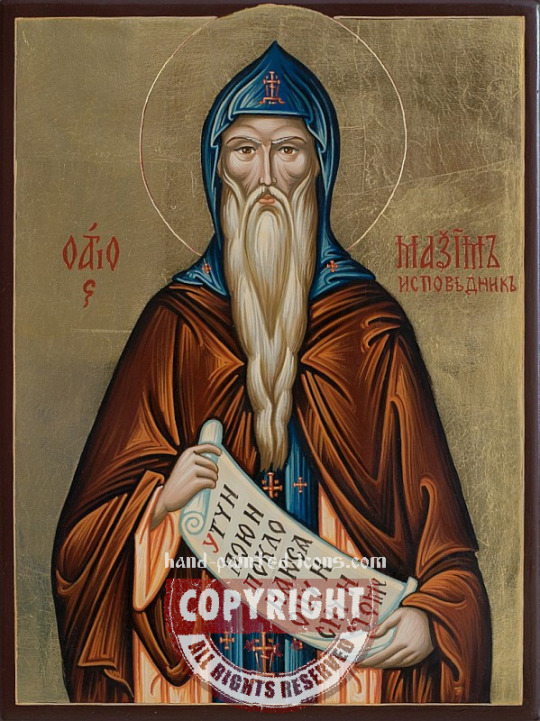
Saint Maximus the Confessor was born in Constantinople around 580 and raised in a pious Christian family. He received an excellent education, studying philosophy, grammar, and rhetoric. He was well-read in the authors of antiquity and he also mastered philosophy and theology. When Saint Maximus entered into government service, he became first secretary (asekretis) and chief counselor to the emperor Heraclius (611-641), who was impressed by his knowledge and virtuous life.
Saint Maximus soon realized that the emperor and many others had been corrupted by the Monothelite heresy, which was spreading rapidly through the East. He resigned from his duties at court, and went to the Chrysopolis monastery (at Skutari on the opposite shore of the Bosphorus), where he received monastic tonsure. Because of his humility and wisdom, he soon won the love of the brethren and was chosen igumen of the monastery after a few years. Even in this position, he remained a simple monk.
In 638, the emperor Heraclius and Patriarch Sergius tried to minimize the importance of differences in belief, and they issued an edict, the “Ekthesis” (“Ekthesis tes pisteos” or “Exposition of Faith),” which decreed that everyone must accept the teaching of one will in the two natures of the Savior. In defending Orthodoxy against the “Ekthesis,” Saint Maximus spoke to people in various occupations and positions, and these conversations were successful. Not only the clergy and the bishops, but also the people and the secular officials felt some sort of invisible attraction to him, as we read in his Life.
When Saint Maximus saw what turmoil this heresy caused in Constantinople and in the East, he decided to leave his monastery and seek refuge in the West, where Monothelitism had been completely rejected. On the way, he visited the bishops of Africa, strengthening them in Orthodoxy, and encouraging them not to be deceived by the cunning arguments of the heretics.
The Fourth Ecumenical Council had condemned the Monophysite heresy, which falsely taught that in the Lord Jesus Christ there was only one nature (the divine). Influenced by this erroneous opinion, the Monothelite heretics said that in Christ there was only one divine will (“thelema”) and only one divine energy (“energia”). Adherents of Monothelitism sought to return by another path to the repudiated Monophysite heresy. Monothelitism found numerous adherents in Armenia, Syria, Egypt. The heresy, fanned also by nationalistic animosities, became a serious threat to Church unity in the East. The struggle of Orthodoxy with heresy was particularly difficult because in the year 630, three of the patriarchal thrones in the Orthodox East were occupied by Monothelites: Constantinople by Sergius, Antioch by Athanasius, and Alexandria by Cyrus.
Saint Maximus traveled from Alexandria to Crete, where he began his preaching activity. He clashed there with a bishop, who adhered to the heretical opinions of Severus and Nestorius. The saint spent six years in Alexandria and the surrounding area.
Patriarch Sergius died at the end of 638, and the emperor Heraclius also died in 641. The imperial throne was eventually occupied by his grandson Constans II (642-668), an open adherent of the Monothelite heresy. The assaults of the heretics against Orthodoxy intensified. Saint Maximus went to Carthage and he preached there for about five years. When the Monothelite Pyrrhus, the successor of Patriarch Sergius, arrived there after fleeing from Constantinople because of court intrigues, he and Saint Maximus spent many hours in debate. As a result, Pyrrhus publicly acknowledged his error, and was permitted to retain the title of “Patriarch.” He even wrote a book confessing the Orthodox Faith. Saint Maximus and Pyrrhus traveled to Rome to visit Pope Theodore, who received Pyrrhus as the Patriarch of Constantinople.
In the year 647 Saint Maximus returned to Africa. There, at a council of bishops Monotheletism was condemned as a heresy. In 648, a new edict was issued, commissioned by Constans and compiled by Patriarch Paul of Constantinople: the “Typos” (“Typos tes pisteos” or “Pattern of the Faith”), which forbade any further disputes about one will or two wills in the Lord Jesus Christ. Saint Maximus then asked Saint Martin the Confessor (April 14), the successor of Pope Theodore, to examine the question of Monothelitism at a Church Council. The Lateran Council was convened in October of 649. One hundred and fifty Western bishops and thirty-seven representatives from the Orthodox East were present, among them Saint Maximus the Confessor. The Council condemned Monothelitism, and the Typos. The false teachings of Patriarchs Sergius, Paul and Pyrrhus of Constantinople, were also anathematized.
When Constans II received the decisions of the Council, he gave orders to arrest both Pope Martin and Saint Maximus. The emperor’s order was fulfilled only in the year 654. Saint Maximus was accused of treason and locked up in prison. In 656 he was sent to Thrace, and was later brought back to a Constantinople prison.
The saint and two of his disciples were subjected to the cruelest torments. Each one’s tongue was cut out, and his right hand was cut off. Then they were exiled to Skemarum in Scythia, enduring many sufferings and difficulties on the journey.
After three years, the Lord revaled to Saint Maximus the time of his death (August 13, 662). Three candles appeared over the grave of Saint Maximus and burned miraculously. This was a sign that Saint Maximus was a beacon of Orthodoxy during his lifetime, and continues to shine forth as an example of virtue for all. Many healings occurred at his tomb.
In the Greek Prologue, August 13 commemorates the Transfer of the Relics of Saint Maximus to Constantinople, but it could also be the date of the saint’s death. It may be that his memory is celebrated on January 21 because August 13 is the Leavetaking of the Feast of the Transfiguration of the Lord.
Saint Maximus has left to the Church a great theological legacy. His exegetical works contain explanations of difficult passages of Holy Scripture, and include a Commentary on the Lord’s Prayer and on Psalm 59, various “scholia” or “marginalia” (commentaries written in the margin of manuscripts), on treatises of the Hieromartyr Dionysius the Areopagite (October 3) and Saint Gregory the Theologian (January 25). Among the exegetical works of Saint Maximus are his explanation of divine services, entitled “Mystagogia” (“Introduction Concerning the Mystery”).
The dogmatic works of Saint Maximus include the Exposition of his dispute with Pyrrhus, and several tracts and letters to various people. In them are contained explanations of the Orthodox teaching on the Divine Essence and the Persons of the Holy Trinity, on the Incarnation of the Word of God, and on “theosis” (“deification”) of human nature.
“Nothing in theosis is the product of human nature,” Saint Maximus writes in a letter to his friend Thalassius, “for nature cannot comprehend God. It is only the mercy of God that has the capacity to endow theosis unto the existing... In theosis man (the image of God) becomes likened to God, he rejoices in all the plenitude that does not belong to him by nature, because the grace of the Spirit triumphs within him, and because God acts in him” (Letter 22).
Saint Maximus also wrote anthropological works (i.e. concerning man). He deliberates on the nature of the soul and its conscious existence after death. Among his moral compositions, especially important is his “Chapters on Love.” Saint Maximus the Confessor also wrote three hymns in the finest traditions of church hymnography, following the example of Saint Gregory the Theologian.
The theology of Saint Maximus the Confessor, based on the spiritual experience of the knowledge of the great Desert Fathers, and utilizing the skilled art of dialectics worked out by pre-Christian philosophy, was continued and developed in the works of Saint Simeon the New Theologian (March 12), and Saint Gregory Palamas (November 14).
SAINT TIKHON OF ZADONSK, BISHOP OF VORONEZH (1783)
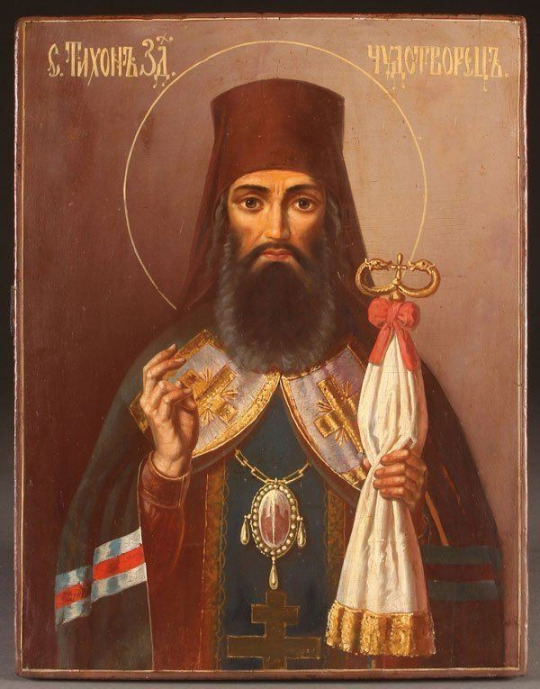
Saint Tikhon of Zadonsk, Bishop of Voronezh (in the world Timothy), was born in the year 1724 in the village of Korotsk in the Novgorod diocese, into the family of the cantor Sabellius Kirillov. (Afterward, a new family name, Sokolov, was given him by the head of the Novgorod Seminary). His father died when Timothy was a young child, leaving the family in such poverty that his mother was barely able to make ends meet. She wanted to give him to be raised by a neighbor, a coachman, since there was no other way to feed the family, but his brother Peter would not permit this. Timothy often worked a whole day with the peasants for a single piece of black bread.
As a thirteen-year-old boy, he was sent to a clergy school near the Archbishop of Novgorod's residence, and earned his keep by working with the vegetable gardeners. In 1740, he was accepted under a state grant set up for the Novgorod Seminary. The youth excelled at his studies. Upon finishing seminary in 1754, he became a teacher there, first in Greek, and later in Rhetoric and Philosophy. In the year 1758, he was tonsured with the name Tikhon. That same year he was appointed as prefect of the Seminary.
In 1759, he was transferred to Tver, and was elevated to the rank of Archimandrite of Zheltikov Monastery. Later, he was appointed Rector of the Tver Seminary and, at the same time, Superior of Otroch Monastery.
His election as bishop was providential. Metropolitan Demetrios, the presiding member of the Holy Synod, had intended to transfer the young Archimandrite to the Trinity-Sergiev Lavra. On the day of Pascha, at Peterburg, Archimandrite Tikhon was one of eight candidates being considered for selection as vicar bishop for Novogorod. Metropolitan Demetrios thought he was too young for that position, but agreed to submit his name. The lot fell on Archimandrite Tikhon three times.
On the same day, during the Cherubic Hymn, Bishop Athanasios of Tver, without realizing it, commemorated him as a bishop while cutting particles from the prosphora at the Table of Oblation. On May 13, 1761 he was consecrated as Bishop of Keksgolma and Ladoga (i.e., vicar bishop of the Novgorod diocese).
In 1763, Saint Tikhon was transferred to the See of Voronezh. For the four and a half years that he administered the diocese of Voronezh, Vladyka provided constant edification, both by his life and by his numerous pastoral counsels and soul-profiting books. He also wrote a whole series of works for pastors:
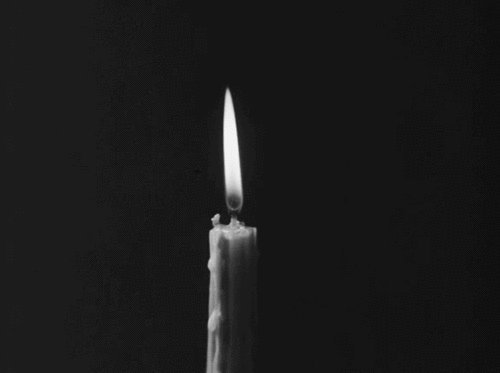
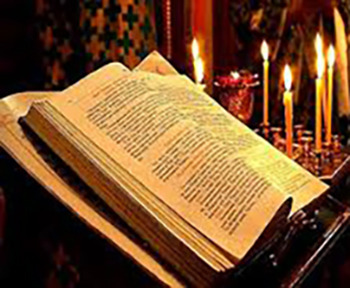
1 CORINTHIANS 1:26-29
26 For you see your calling, brethren, that not many wise according to the flesh, not many mighty, not many noble, are called. 27 But God has chosen the foolish things of the world to put to shame the wise, and God has chosen the weak things of the world to put to shame the things which are mighty; 28 and the base things of the world and the things which are despised God has chosen, and the things which are not, to bring to nothing the things that are, 29 that no flesh should glory in His presence.
MATTHEW 20:29-34
29 Now as they went out of Jericho, a great multitude followed Him. 30 And behold, two blind men sitting by the road, when they heard that Jesus was passing by, cried out, saying, "Have mercy on us, O Lord, Son of David!" 31 Then the multitude warned them that they should be quiet; but they cried out all the more, saying, "Have mercy on us, O Lord, Son of David!" 32 So Jesus stood still and called them, and said, "What do you want Me to do for you?" 33 They said to Him, "Lord, that our eyes may be opened." 34 So Jesus had compassion and touched their eyes. And immediately their eyes received sight, and they followed Him.
#orthodoxy#orthodoxchristianity#easternorthodoxchurch#originofchristianity#spirituality#holyscriptures#gospel#wisdom#saints
3 notes
·
View notes
Text
0 notes
Text
British Library digitised image from page 163 of "The Monks of Thelema. A novel. (Reprinted from 'The World.')"

Image taken from: Title: "The Monks of Thelema. A novel. (Reprinted from 'The World.')" Author(s): Rice, James, novelist [person] ; Besant, Walter, 1836-1901 [person] British Library shelfmark: "Digital Store 12639.o.3" Page: 163 (scanned page number - not necessarily the actual page number in the publication) Place of publication: London (England) Date of publication: 1878 Publisher: Chatto & Windus Type of resource: Monograph Physical description: 3 volumes (8°) Explore this item in the British Library’s catalogue: 000302663 (physical copy) and 014805172 (digitised copy) (numbers are British Library identifiers) Other links related to this image: - View this image as a scanned publication on the British Library’s online viewer (you can download the image, selected pages or the whole book) - Order a higher quality scanned version of this image from the British Library Other links related to this publication: - View all the illustrations found in this publication - View all the illustrations in publications from the same year (1878) - Download the Optical Character Recognised (OCR) derived text for this publication as JavaScript Object Notation (JSON) - Explore and experiment with the British Library’s digital collections The British Library community is able to flourish online thanks to freely available resources such as this. You can help support our mission to continue making our collection accessible to everyone, for research, inspiration and enjoyment, by donating on the British Library supporter webpage here. Thank you for supporting the British Library. from BLPromptBot https://ift.tt/2SZQEGV
0 notes
Photo
This is an Eastern Orthodox Christian Schema monk, it has nothing to do with Crowley, OTO, Thelema and such

662 notes
·
View notes
Text
Aleister Crowley, Francois Rabelais and the Herb of Thelema
CANNABIS CULTURE - Aleister Crowley is a well known 19th-20th century magician, Francois Rabelais was a 16th century monk, remembered largely for his well known work of satire Gargantua and Pantagruel, what could these two and cannabis have in common? Possibly the most intriguing renaissance figure involved with the history of cannabis was the 16th century Monk, Alchemist and Bachelor of Medicine, Francois Rabelais, (1494-1553). Rabelais is best known for his hilarious epic adventure Gargantua…
0 notes
Text
Aleister Crowley, Francois Rabelais and the Herb of Thelema
CANNABIS CULTURE - Aleister Crowley is a well known 19th-20th century magician, Francois Rabelais was a 16th century monk, remembered largely for his well known work of satire Gargantua and Pantagruel, what could these two and cannabis have in common? Possibly the most intriguing renaissance figure involved with the history of cannabis was the 16th century Monk, Alchemist and Bachelor of Medicine, Francois Rabelais, (1494-1553). Rabelais is best known for his hilarious epic adventure Gargantua…
Aleister Crowley, Francois Rabelais and the Herb of Thelema posted first on http://uppercanadaseedbank.blogspot.com
0 notes
Text
Aleister Crowley, Francois Rabelais and the Herb of Thelema
CANNABIS CULTURE - Aleister Crowley is a well known 19th-20th century magician, Francois Rabelais was a 16th century monk, remembered largely for his well known work of satire Gargantua and Pantagruel, what could these two and cannabis have in common? Possibly the most intriguing renaissance figure involved with the history of cannabis was the 16th century Monk, Alchemist and Bachelor of Medicine, Francois Rabelais, (1494-1553). Rabelais is best known for his hilarious epic adventure Gargantua…
from Cannabis News https://www.cannabisculture.com/content/2019/02/17/aleister-crowley-francois-rabelais-and-the-herb-of-thelema/
0 notes
Text
Aleister Crowley, Francois Rabelais and the Herb of Thelema
CANNABIS CULTURE - Aleister Crowley is a well known 19th-20th century magician, Francois Rabelais was a 16th century monk, remembered largely for his well known work of satire Gargantua and Pantagruel, what could these two and cannabis have in common? Possibly the most intriguing renaissance figure involved with the history of cannabis was the 16th century Monk, Alchemist and Bachelor of Medicine, Francois Rabelais, (1494-1553). Rabelais is best known for his hilarious epic adventure Gargantua…
from Cannabis News https://www.cannabisculture.com/content/2019/02/17/aleister-crowley-francois-rabelais-and-the-herb-of-thelema/
0 notes
Text
Aleister Crowley, Francois Rabelais and the Herb of Thelema
CANNABIS CULTURE - Aleister Crowley is a well known 19th-20th century magician, Francois Rabelais was a 16th century monk, remembered largely for his well known work of satire Gargantua and Pantagruel, what could these two and cannabis have in common? Possibly the most intriguing renaissance figure involved with the history of cannabis was the 16th century Monk, Alchemist and Bachelor of Medicine, Francois Rabelais, (1494-1553). Rabelais is best known for his hilarious epic adventure Gargantua…
from Cannabis News https://www.cannabisculture.com/content/2019/02/17/aleister-crowley-francois-rabelais-and-the-herb-of-thelema/
0 notes
Note
Hi! I saw your post answering an ask from before talking about Thelema and their differences from “the cult” in Kuroshitsuji. It made me curious, do you know if the cult shown in Kuro has a basis on anything (any existing cults, movements, religions, occurrences, etc.) from the Victorian Era? Or just history in general?
Besides what's already mentioned?
Idk 🤷🏻♀️ maybe just about any mystery religion or occult religion of the Victorian era? Or earlier. Or a bit later....
Not so much the actual historical cults or secret societies... but what society-at-large assumed about such things. People often called them Hellfire clubs and thought the members were into demon worship. It's a lot like Satanic Panic. Those organizations rarely get up to the sorts of activities they're accused of. Just look at Stranger Things: the D&D club calls itself the Hellfire Club... and the community doesn't understand what they are into, so they claim the kids are performing demonic rituals, killing people, etc. That's pretty intentional, on the part of the writers, to call them that and have them deal with religious conservative adversaries. Totally a classic Satanic Panic situation of the 1980's.
Same sort of thing happened in earlier generations and centuries. People who weren't privy to what actually happened in such organizations didn't understand and would assume "the worst". Even clubs like the Monks of Medmenham were called "Hellfire" clubs as a somewhat derogatory term. By the Victorian era, many didn't know what old, dissolved clubs like that once did, so they let their imaginations take over.
Yana-san basically created a club that does the exact sorts of things the real clubs of the time, as well as earlier clubs, didn't actually do... but were often accused of doing.
#black butler#kuroshitsuji#demon cult#demon worship#hellfire club#thelema#monks of medmenham#satanic panic#anon asks#i answer#answered asks#jul 25 2023
21 notes
·
View notes
Text
Saints&Reading: Friday, January 4, 2023
january 4_january 21
VENERABLE MAXIMUS THE CONFESSOR (662)
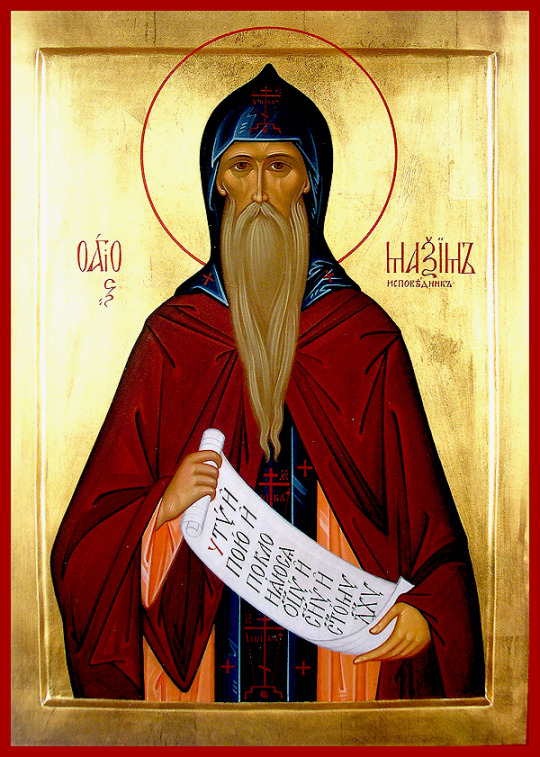
Saint Maximus the Confessor was born in Constantinople around 580 and raised in a pious Christian family. He received an excellent education, studying philosophy, grammar, and rhetoric. He was well-read in the authors of antiquity and he also mastered philosophy and theology. When Saint Maximus entered into government service, he became first secretary (asekretis) and chief counselor to the emperor Heraclius (611-641), who was impressed by his knowledge and virtuous life.
Saint Maximus soon realized that the emperor and many others had been corrupted by the Monothelite heresy, which was spreading rapidly through the East. He resigned from his duties at court, and went to the Chrysopolis monastery (at Skutari on the opposite shore of the Bosphorus), where he received monastic tonsure. Because of his humility and wisdom, he soon won the love of the brethren and was chosen igumen of the monastery after a few years. Even in this position, he remained a simple monk.
In 638, the emperor Heraclius and Patriarch Sergius tried to minimize the importance of differences in belief, and they issued an edict, the “Ekthesis” (“Ekthesis tes pisteos” or “Exposition of Faith),” which decreed that everyone must accept the teaching of one will in the two natures of the Savior. In defending Orthodoxy against the “Ekthesis,” Saint Maximus spoke to people in various occupations and positions, and these conversations were successful. Not only the clergy and the bishops, but also the people and the secular officials felt some sort of invisible attraction to him, as we read in his Life.
When Saint Maximus saw what turmoil this heresy caused in Constantinople and in the East, he decided to leave his monastery and seek refuge in the West, where Monothelitism had been completely rejected. On the way, he visited the bishops of Africa, strengthening them in Orthodoxy, and encouraging them not to be deceived by the cunning arguments of the heretics.
The Fourth Ecumenical Council had condemned the Monophysite heresy, which falsely taught that in the Lord Jesus Christ there was only one nature (the divine). Influenced by this erroneous opinion, the Monothelite heretics said that in Christ there was only one divine will (“thelema”) and only one divine energy (“energia”). Adherents of Monothelitism sought to return by another path to the repudiated Monophysite heresy. Monothelitism found numerous adherents in Armenia, Syria, Egypt. The heresy, fanned also by nationalistic animosities, became a serious threat to Church unity in the East. The struggle of Orthodoxy with heresy was particularly difficult because in the year 630, three of the patriarchal thrones in the Orthodox East were occupied by Monothelites: Constantinople by Sergius, Antioch by Athanasius, and Alexandria by Cyrus.
Saint Maximus traveled from Alexandria to Crete, where he began his preaching activity. He clashed there with a bishop, who adhered to the heretical opinions of Severus and Nestorius. The saint spent six years in Alexandria and the surrounding area.
Patriarch Sergius died at the end of 638, and the emperor Heraclius also died in 641. The imperial throne was eventually occupied by his grandson Constans II (642-668), an open adherent of the Monothelite heresy. The assaults of the heretics against Orthodoxy intensified. Saint Maximus went to Carthage and he preached there for about five years. When the Monothelite Pyrrhus, the successor of Patriarch Sergius, arrived there after fleeing from Constantinople because of court intrigues, he and Saint Maximus spent many hours in debate. As a result, Pyrrhus publicly acknowledged his error, and was permitted to retain the title of “Patriarch.” He even wrote a book confessing the Orthodox Faith. Saint Maximus and Pyrrhus traveled to Rome to visit Pope Theodore, who received Pyrrhus as the Patriarch of Constantinople.
In the year 647 Saint Maximus returned to Africa. There, at a council of bishops Monotheletism was condemned as a heresy. In 648, a new edict was issued, commissioned by Constans and compiled by Patriarch Paul of Constantinople: the “Typos” (“Typos tes pisteos” or “Pattern of the Faith”), which forbade any further disputes about one will or two wills in the Lord Jesus Christ. Saint Maximus then asked Saint Martin the Confessor (April 14), the successor of Pope Theodore, to examine the question of Monothelitism at a Church Council. The Lateran Council was convened in October of 649. One hundred and fifty Western bishops and thirty-seven representatives from the Orthodox East were present, among them Saint Maximus the Confessor. The Council condemned Monothelitism, and the Typos. The false teachings of Patriarchs Sergius, Paul and Pyrrhus of Constantinople, were also anathematized.
When Constans II received the decisions of the Council, he gave orders to arrest both Pope Martin and Saint Maximus. The emperor’s order was fulfilled only in the year 654. Saint Maximus was accused of treason and locked up in prison. In 656 he was sent to Thrace, and was later brought back to a Constantinople prison.
The saint and two of his disciples were subjected to the cruelest torments. Each one’s tongue was cut out, and his right hand was cut off. Then they were exiled to Skemarum in Scythia, enduring many sufferings and difficulties on the journey.
After three years, the Lord revaled to Saint Maximus the time of his death (August 13, 662). Three candles appeared over the grave of Saint Maximus and burned miraculously. This was a sign that Saint Maximus was a beacon of Orthodoxy during his lifetime, and continues to shine forth as an example of virtue for all. Many healings occurred at his tomb.
In the Greek Prologue, August 13 commemorates the Transfer of the Relics of Saint Maximus to Constantinople, but it could also be the date of the saint’s death. It may be that his memory is celebrated on January 21 because August 13 is the Leavetaking of the Feast of the Transfiguration of the Lord.
Saint Maximus has left to the Church a great theological legacy. His exegetical works contain explanations of difficult passages of Holy Scripture, and include a Commentary on the Lord’s Prayer and on Psalm 59, various “scholia” or “marginalia” (commentaries written in the margin of manuscripts), on treatises of the Hieromartyr Dionysius the Areopagite (October 3) and Saint Gregory the Theologian (January 25). Among the exegetical works of Saint Maximus are his explanation of divine services, entitled “Mystagogia” (“Introduction Concerning the Mystery”).
The dogmatic works of Saint Maximus include the Exposition of his dispute with Pyrrhus, and several tracts and letters to various people. In them are contained explanations of the Orthodox teaching on the Divine Essence and the Persons of the Holy Trinity, on the Incarnation of the Word of God, and on “theosis” (“deification”) of human nature.
“Nothing in theosis is the product of human nature,” Saint Maximus writes in a letter to his friend Thalassius, “for nature cannot comprehend God. It is only the mercy of God that has the capacity to endow theosis unto the existing... In theosis man (the image of God) becomes likened to God, he rejoices in all the plenitude that does not belong to him by nature, because the grace of the Spirit triumphs within him, and because God acts in him” (Letter 22).
Saint Maximus also wrote anthropological works (i.e. concerning man). He deliberates on the nature of the soul and its conscious existence after death. Among his moral compositions, especially important is his “Chapters on Love.” Saint Maximus the Confessor also wrote three hymns in the finest traditions of church hymnography, following the example of Saint Gregory the Theologian.
The theology of Saint Maximus the Confessor, based on the spiritual experience of the knowledge of the great Desert Fathers, and utilizing the skilled art of dialectics worked out by pre-Christian philosophy, was continued and developed in the works of Saint Simeon the New Theologian (March 12), and Saint Gregory Palamas (November 14).
Source: Orthodox Church in America_OCA
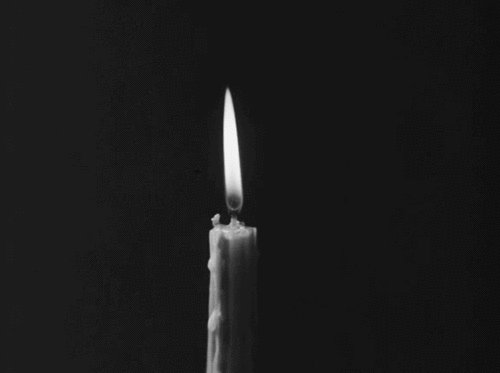
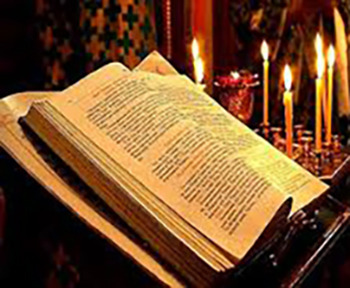
MARK 13:1-8
1 Then as He went out of the temple, one of His disciples said to Him, "Teacher, see what manner of stones and what buildings are here!" 2 And Jesus answered and said to him, "Do you see these great buildings? Not one stone shall be left upon another, that shall not be thrown down." 3 Now as He sat on the Mount of Olives opposite the temple, Peter, James, John, and Andrew asked Him privately, 4 Tell us, when will these things be? And what will be the sign when all these things will be fulfilled? 5 And Jesus, answering them, began to say: "Take heed that no one deceives you. 6 For many will come in My name, saying, 'I am He,' and will deceive many. 7 But when you hear of wars and rumors of wars, do not be troubled; for such things must happen, but the end is not yet. 8 For nation will rise against nation, and kingdom against kingdom. And there will be earthquakes in various places, and there will be famines and troubles. These are the beginnings of sorrows.
2 PETER 1:1-10
1Simon Peter, a bondservant and apostle of Jesus Christ,To those who have obtained like precious faith with us by the righteousness of our God and Savior Jesus Christ: 2 Grace and peace be multiplied to you in the knowledge of God and of Jesus our Lord, 3 as His divine power has given to us all things that pertain to life and godliness, through the knowledge of Him who called us by glory and virtue, 4 by which have been given to us exceedingly great and precious promises, that through these you may be partakers of the divine nature, having escaped the corruption that is in the world through lust. 5 But also for this very reason, giving all diligence, add to your faith virtue, to virtue knowledge, 6 to knowledge self-control, to self-control perseverance, to perseverance godliness, 7 to godliness brotherly kindness, and to brotherly kindness love. 8 For if these things are yours and abound, you will be neither barren nor unfruitful in the knowledge of our Lord Jesus Christ. 9 For he who lacks these things is shortsighted, even to blindness, and has forgotten that he was cleansed from his old sins.10 Therefore, brethren, be even more diligent to make your call and election sure, for if you do these things you will never stumble;
#orthodoxy#orthodoxchristianity#eastern orthodox church#originofchristianity#spirituality#holyscriptures#gospel#bible
4 notes
·
View notes
Text
The History of Alchemy
'Whether regarded as a science or philosophy, chemistry provided the beginnings for interpersonal chemistry and the basis for new-made lab proficiencys. Alchemists believed that the secrets of temperament could be revealed with laboratory experiment and examination and they successfully revealed many of those secrets. chemistry is defined as the process of winning something ordinary and round it into something extraordinary, sometimes in a mood that can non be explained. (YourDictionary.com) This definition, though true, does not cut through all that chemical science is about. chemistry excessively involved the make of transforming anes spirit. If one could pick out how to purify funds, one could use the technique to purify the gentle soul (Thelemapedia: The encyclopaedia of Thelema & Magick).\nAlchemy scratch developed severally in twain Egypt and China. In China, the creators of chemical science were Taoist monks. Consequently, Chinese alchemy was ground on Taoist beliefs and practices. Wei Po-Yang is credited with the pedestal of Chinese alchemy. The Chinese primary coating of alchemy was not the transmutation of base metals into gold. When alchemy began in China, the word of honor for gold was not to date a word in the Chinese language. The primary remnant of Chinese alchemy was to discover the philosophers stone of life-time, a marrow squash that when ingested, brings eternal life. In Chinese alchemy exercise techniques were adept with the purpose of manipulating ones life force and prolonging life. Minerals and plants were in like manner ingested for the same purpose. Alchemy spread to India from China. The Indians in force(p) alchemy in the same way as the Chinese ( The Magic and fiction of Alchemy).\nBy n other(a) the 4th coulomb BCE in Egypt, in that location was a raw material practice of alchemy in place. It was practiced by the priestlike class. Alexandria was the center of alchemical knowledge. Most nurtur e about early alchemy in Egypt has been lost due(p) to their library in Alexandria being burnt-out when the Christians invaded. (The Magic and...'
0 notes
Text
Image taken from page 283 of 'The Monks of Thelema. A novel. (Reprinted from “The World.”)'

Image taken from: Title: "The Monks of Thelema. A novel. (Reprinted from “The World.”)" Author: Besant, Walter - Sir Contributor: RICE, James - Novelist Shelfmark: "British Library HMNTS 12639.o.3." Volume: 01 Page: 283 Place of Publishing: London Date of Publishing: 1878 Publisher: Chatto & Windus Issuance: monographic Identifier: 000302663 Explore: Find this item in the British Library catalogue, 'Explore'. Open the page in the British Library's itemViewer (page image 283) Download the PDF for this book Image found on book scan 283 (NB not a pagenumber)Download the OCR-derived text for this volume: (plain text) or (json) Click here to see all the illustrations in this book and click here to browse other illustrations published in books in the same year. Order a higher quality version from here. from BLPromptBot https://ift.tt/2IOO5zy
0 notes
Text
Another weekend almost over. Another week with little to no time to myself. Actually 2 weeks today. I needed tonight so bad, and I feel so lucky to have gotten this evening/night. I even got some personal work done, and not the kind of psychotic mental masturbation I usually mean, well, hopefully maybe later. I mean I got, well, at least a lot of my work laundry done, dishes washed, stuff organized, got my room smelling pretty good from my new oil warmer, and I picked up, some at least. Still need work on that, but I found my medical clinic application and got most of that done. Might even get some self discovery work done in this group I'm in with my counselor. My bestie (neighbor/co-worker/friend) and I are the only ones in there. It's supposed to explore our God given gifts and talents, although monotheism is still difficult for me. I'm willing to try, with what I always considered schizophrenia when I was a child, maybe it might help thinking of it as being God touched, even though I know I'm a fraud in this Bible belt southern world. I know I can help more people if I pretend. My whole world depends on what may or may not be a charade of my Christianity. Work, housing, support, family, all of it. Makes me feel a little bit forced, almost as much as when I was 11 and my mom converted from Wicca/Thelema to Lutheranism and I had to go to that school. She was trying to save my soul, I know that, but it was a really weird transition, especially considering I'd been reading the Bible, and quoting parts I hadn't even read since I was 5 or 6, then got held back from 8th grade because my math was rusty (would just have put me in remedial) but my mom said I didn't know the Bible. She was wrong of course, which my religion teacher quickly found out. So yeah, it's hard for me to tell anymore if I'm being genuine or if I really believe. Really, I'm an existential nihilist. Nobody exists on purpose, no one belongs anywhere, and we're all going to die. Doesn't go over well here. Doesn't lend to close friends, or good company. I always find a silver lining though, because what else is there to do? Strengthen others the best I can, love and care for people all the more because there's no giant in sandals to do it for us? I really mostly believe in Christianity as an often positive social construct. We'd all be better off as Buddhist monks, but I can't talk because I have so many psychiatric issues, my desire is pathological at this point. Obsessive compulsive and borderline personality and anxiety make it pretty much impossible to eliminate desire for me, but meditation and focus on trying to makes me feel a lot better. But it's not what they want. And it's not enough.
0 notes